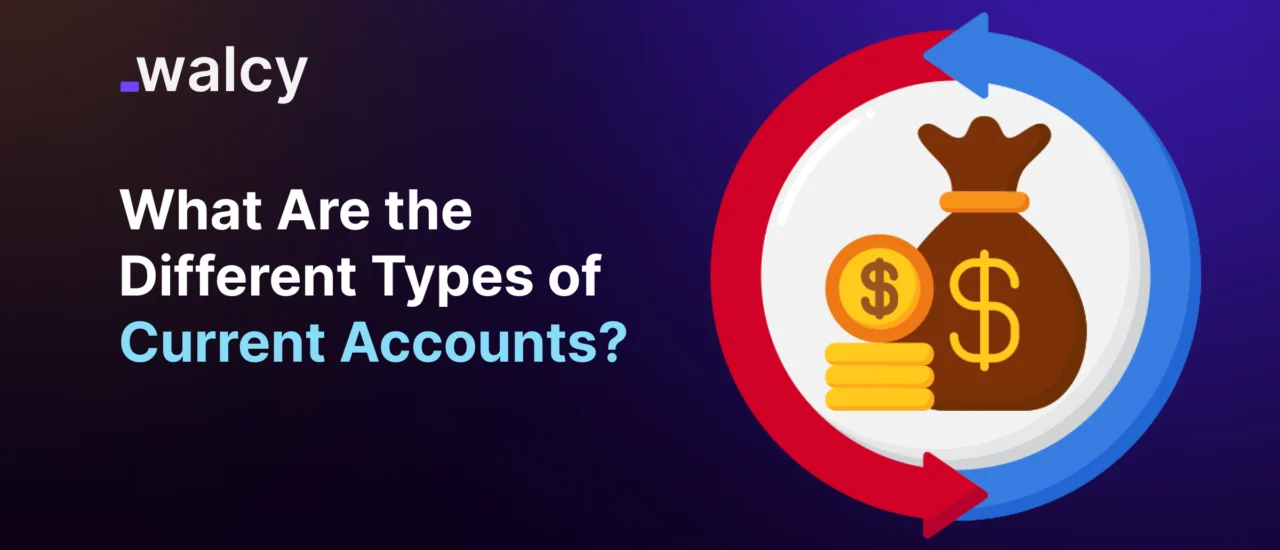Essentially, current accounts are requisites for individuals and businesses. Unlike savings accounts, they grant more leeway to people who require frequent transactions.
Whether running a business or dealing with personal finances, it’s appropriate that an understanding of the available types of current accounts will help you find the right account that best suits your needs.
This blog will look at what a current account is, the available types, their features, and how to open it online.
What is a Current Account?
A current account is a banking facility used in day-to-day business dealings and personal use. One requires high liquidity of the funds deposited in his account and, therefore, easy access to the money.
Favored by companies, traders, entrepreneurs, and individuals, this type of account is suitable for those needing the ability to process frequent large transactions without limitations.
Providing features such as instant money transfers, Cheque clearance, and access to overdraft facilities allows the flexibility needed to maintain cash flow for operational needs.
Most existing accounts also have different banking facilities, such as debit cards, online banking, and multi-currency accounts to deal with international payments.
They usually do not carry interest as in the case of savings accounts, but it ensures smooth management: bills are paid without hassle, payroll is distributed smoothly, and daily needs are easily dealt with.
It may be for business or personal finance management, but a current account plays an important role in handling day-to-day transactions efficiently.
Types of Current Accounts
Current accounts come in various forms, each tailored to meet the specific needs of individuals and businesses.
Below are the different types of current accounts, ranging from basic personal accounts to more complex options for businesses and international transactions.
-
Personal Current Account
This is the simplest form of current account, which is devised for individual users to accommodate their personal financial needs.
One can easily perform transactions with this, coupled with checkbooks, debit cards, and online banking facilities. Being simple doesn’t discard current account charges, though; depending on the services used.
-
Business Current Account
While targeting businesses, entrepreneurs, and organizations, the business current account can carry out a large number of transactions and include additional services such as overdraft facilities, multi-users, and transaction limits to accommodate business needs.
Business current accounts are quite straightforward to set up at most banks, and it’s also a requirement for cash flow management purposes in business.
-
Premium Current Account
Apart from this type of account come added benefits such as reduced transaction fees, a personal relationship manager, and specialized services.
The premium current accounts require higher deposits but in turn, come with additional benefits such as higher limits on withdrawals and reduced charges on the current account.
-
Packaged Current Account
The packaged current accounts include additional services such as travel insurance, phone insurance, or breakdown recovery service.
This type of account also entails a monthly charge but offers great value for money for the individual who desires convenience and a bit more protection along with their banking.
-
Basic Current Account
This is for those who have had problems with banking in the past or for whom other types of accounts do not qualify. Typically, there isn’t an overdraft facility for a basic current account, and features may also be limited.
-
Foreign Currency Current Account
Such an account would be ideal for a company or an individual who deals in several types of currency, as it allows the owner to transact in foreign currencies, avoiding the conversion fees, hence ideal for international operations of business.
Features of Current Accounts
Unlimited Transactions:
As opposed to savings accounts, in current accounts, there is no limit on the number of transactions one can make in a day. It is highly useful for business firms or persons who need to conduct deposits and withdrawals without any limitation.
Overdraft Facility:
Most of the current accounts have the option for overdraft, where one is allowed to spend more than the amount held in the account. It serves as an added precaution against short-term cash flow needs. This advantage might include some extra fees or interest charges.
Cheque Book Facility:
Most current accounts come with a checkbook facility to facilitate payment or withdrawal in cases where digital payment may not be enough. This is the traditional way, which still holds good, especially in business transactions.
Read about: How Global Bank Accounts Differ To Traditional Bank Accounts
E-banking:
Most banks provide this facility through their online portals; one can easily open a current account and get it maintained with them. It also facilitates online management, right from tracking transactions, and bill payments, and even reaching customer care without personally visiting a branch.
Debit Cards:
Debit cards, besides checkbooks, are provided along with current accounts for easy access to cash in an account. These cards permit the holder to withdraw money from ATMs, pay either in stores or online, and can even be attached to digital wallets for contactless transactions.
Multi-User Access:
Most business current accounts come with multi-user access, wherein multiple persons authorized to operate the account effectively are allowed. It is very useful in companies where employees of different levels have to deal with financial transactions.
Customizable Transaction Limits:
At least some current accounts, especially in the premium and business classes, have the facility of customizable daily transaction limits. Such flexibility assists the user in handling large or small volumes of payments according to their need.
Auto-Sweep Facility:
Some current accounts provide an auto-sweep facility whereby surplus funds are automatically transferred from the current account to a fixed deposit account linked to it. In this way, one can accrue interest on unutilized balances and at the same time avail money readily whenever required.
How to Open a Current Account Online?
Opening a current account online has been quite easy these days. It is a step-by-step process described as follows:
- Account Type: Choose the kind of current account you want to open, such as personal, business, or premium current account.
- Login to Bank Website: Go to the bank’s website and click on the option indicating opening an online current account.
- Filling the Application Form: Once the applicant has chosen the medium of application, they fill out the form with their personal or business information.
- Uploading Documents: The applicant needs to upload identification documents and proof of address in the discussion below.
- Verification: Once the form is submitted, the bank will verify the details against their checklist.
- Account Activation: The bank will let you know once this is approved, and hence, your current account gets activated.
Documents Required to Open a Current Account
- Proof of Identification: It needs to verify the identity of the person or owner of the business with a passport, driving license, or any identity proof issued by the government. This is to protect against opening an account on fictitious or sham credentials.
- Proof of Residence: Utility bill, agreement of rent, or property papers will be required to confirm the residential or business address of the applicant. This will be very helpful for record and communication purposes.
- Business Proof: This is necessary to prove that there exists a business and could include business registration certificates, partnership deeds, or even a GST certificate. Such documents ensure the account is put to proper use with regard to business transactions.
- PAN or Aadhaar Card: One would also need to provide a PAN or Aadhaar card to link their account with the financial system for compliance regarding tax matters.
- Bank Reference Letter (Optional): This could be a letter of reference required by some banks, either from an existing customer or from a previous bank to confirm the financial credibility of the applicant.
Benefits of a Current Account
Some of the main advantages enjoyed by current accounts make them a daily need in financial transactions. This includes,
- Facilitates Large Volume of Transactions: Current accounts suit those individuals or businesspeople who have to deposit and withdraw cash quite frequently. This type of account facility suits regular business very well since there is no limit on transactions.
- Overdraft Facility: The facility is such that users may account for temporary shortfalls in liquidity by over-drawing on accounts up to a predetermined, sanctioned limit. This is especially useful during those periods when cash flow is strained, and such succor would be available on immediate demand.
- Liquidity: Access to liquid funds comes in the form of debit cards, checkbooks, and online banking. From withdrawing money from ATMs to paying bills online, current accounts let one maintain liquidity whenever needed.
- Payment of Bills: Paying regular bills such as utility bills, rents, and supplier payments is easier to handle with current accounts. The facility of setting automatic payments ensures timely payments and better financial organization.
- Accounting Tools: Banks provide a record of all transactions and financial statements, which enable the users to track their income and expenses, showing the overall cash flow. Such facilities are basically indispensable in budgeting and efficient financial planning.
- Multi-Currency Support: Most current accounts, especially business current accounts, support multiple currencies, making them fit for international transactions. This will avoid conversion fees and facilitate sending or receiving money from any part of the world.
- Security Features: Most current accounts available today are specifically designed with fraud detection, multi-factor authentication, and encryption features for the security of funds and information. It helps prevent unauthorized transactions and even account breaches.
Read about: Best Multicurrency Account: What Is It And How It Works? International Payment Fees | The Essential guide.
Conclusion
Understanding the different types of current accounts is thus very important, which shall help in making an informed decision based on one’s needs.
Opening a personal current account for everyday dealing or a business current account meant for high-volume transactions, choosing the right one can bring loads of benefits and help to manage your funds with much ease. Opening an account online is pretty easy these days and requires minimal documentation and effort.
Do follow us on Facebook and LinkedIn, to stay connected with us.



